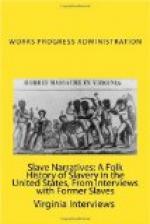The spring on the Lincoln Farm that falls from a cliff was a place associated with Indian cruelty. It was here in the pool of water below the cliff that the Indians would throw babies of the settlers. If the little children could swim or the settlers could rescue them they escaped, otherwise they were drowned. The Indians would gather around the scene of the tragedy and rejoice in their fashion. The old slave when he was a baby was thrown in this pool but was rescued by white people. He remembers having seen several Indians but not many.
The most interesting subject that Billy Slaughter discussed was the Civil War. This was ordinarily believed to be fought over slavery, but it really was not, according to his interpretation, which is unusual for an old slave to state. The real reason was that the South withdrew from the Union and elected Jefferson Davis President of the Confederacy. In his own dialect he narrated these events accurately. The southerners or Democrats were called “Rebels” and “Secess” and the Republicans were called “Abolitionists.”
Another point of interest was John Brown and Harpers Ferry. When Harper’s Ferry was fired upon, that was firing upon the United States. It was here and through John Brown’s Raid that war was virtually declared. The old Negro explained that Brown was an Abolitionist, and was captured here and later killed. While the old slave had the utmost respect for the Federal Government he regarded John Brown as a martyr for the cause of freedom and included him among the heroes he worshipped. Among his prized possessions is an old book written about John Brown’s Raid.
The old slave’s real hero was Abraham Lincoln. He plans another pilgrimage to the Lincoln Farm to look again at the cabin in which his Emancipator was born. He asked me if I read history very much. I assured him that I read it to some extent. After that he asked me if I recalled reading about Lincoln during the Civil War walking the White House floor one night and a Negro named Douglas remained in his presence. In the beginning of the War the Negroes who enlisted in the Union Army were given freedom, also the wives, and the children who were not married.
Another problem that was facing the North at this time was that the men who were taken from the farm and factory to the army could not be replaced by the slaves and production continued in the North as was being done in the south. Not all Negroes who wanted to join the Union forces were able to do so because of the strict watchfulness of their masters. The slaves were made to fight in the southern army whether they wanted to or not. This lessened the number of free Negroes in the Northern army. As a result Lincoln decided to free all Negroes. That was the decision he made the night he walked the White House floor. This was the old darkey’s story of the conditions that brought about the Emancipation Proclamation. Freeing the Negroes was brought




